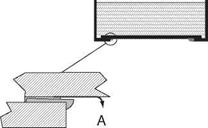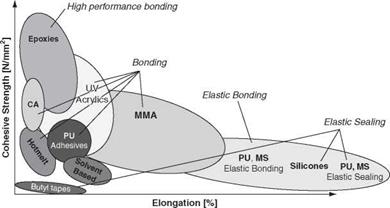Somewhere in the whole catalogue of adhesive families, the product is classified as a ‘sealant’ and not necessarily as an ‘adhesive’. The application itself will tend to define the difference as much as the generic adhesive type. Very often, in order for a sealant
to successfully fulfil its function, it must offer a good degree of adhesion against the surface it is sealing otherwise the media will permeate along the joint line between the sealant and the substrate (Figure 1.26).
One possible method of distinguishing sealants and adhesives is to compare the typical cohesive strength of the products with flexibility (% extension). Figure 1.27 shows how some of the most common adhesives and sealants for the bonding of plastic materials might be classified.
This graph is not entirely correct as there will always be exceptions to the categories but it does show that there is no distinct definition between an adhesive and a sealant.
|
Figure 1.26 If the sealant does not adhere, a leak path is possible (arrow A) |
|
Figure 1.27 Adhesives versus sealants CA = Cyanoacrylate adhesives, MS = modified silane adhesives, PU = polyurethane adhesives, MMA = methylmethacrylate adhesives, UV = ultraviolet cure adhesives |
 9 сентября, 2015
9 сентября, 2015  Pokraskin
Pokraskin 

 Опубликовано в рубрике
Опубликовано в рубрике 